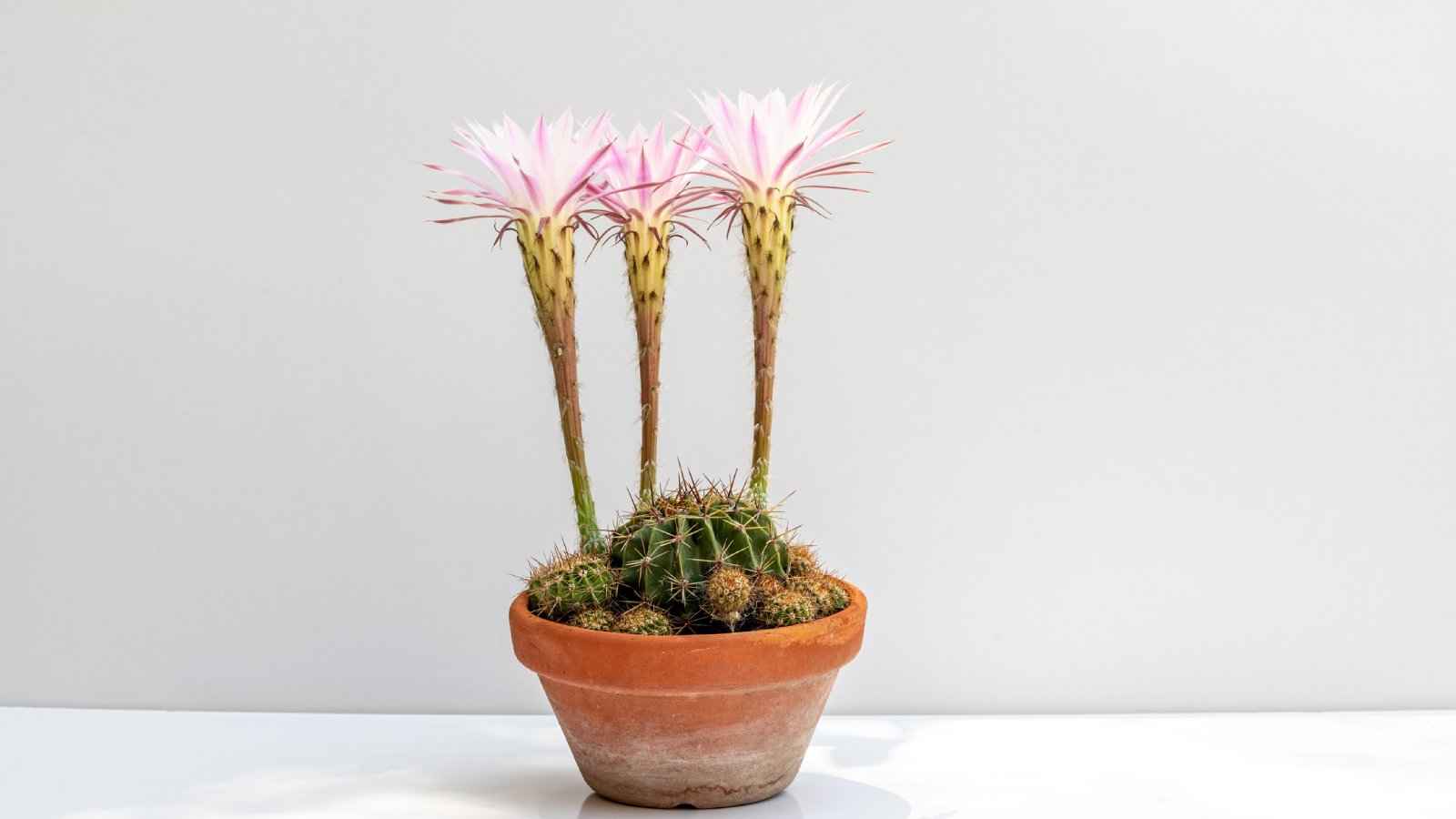How To Grow And Care For An Easter Lily Cactus
Imagine the fragrance of a large bloom from an Easter lily cactus in your home. This unusual cactus loves gritty soil, warm dry air and lots of light.


Quick Easter Lily Cactus Facts
Botanical name: Echinopsis oxygona
Height: 1 foot (0.3 m)
Spread: 2 foot (0.6 m)
Sun exposure: Full
Soil requirements: Well draining, gritty
Hardiness zones: USDA 8-11
When to plant: Spring or summer
Holiday plants make excellent gifts and run the gamut from Christmas cacti to Easter lily cactus. Echinopsis oxygona is a wonderful example of a flowering cactus. It responds to warmer days and longer day hours by producing a tropical bloom that’s larger than the diameter of the small spherical body of the plant. With proper care and the right situation in the home, Echinopsis Easter lily cactus might provide you with an early season bloom year after year.
Easter Lily Cactus Care
Easter lily cactus is a small plant, only measuring 1 foot (.3 m.) in height when fully mature. The body of the plant is a little, rounded clump with numerous ribs arranged around the main form. It produces an early season bloom of funnel-shaped flowers that emit a sweet scent. Although they are closely related, Echinopsis oxygona is not the same cactus plant as Echinopsis eyriessi, which also produces beautiful flowers around early spring.
Light
The Easter lily cactus is native to Bolivia, Uruguay, Argentina, Paraguay, and Southern Brazil. In these climates, it receives plenty of sun throughout the year. In the home, the plant should be placed in a southern or western-facing window, just a bit away from the harshest rays of the day. If there’s inadequate light in the home, use a plant light to supplement the bright exposure it receives. If you want to move the plant outdoors in summer, situate it where it gets at least 8 hours of sun daily.

Want to learn techniques to improve your garden’s climate “score” AND create a beautiful regenerative oasis in your backyard?
Water
Cacti are often thought of as drought-tolerant. Easter lily cactus is no exception, but the best growth will occur when it is kept moderately moist. Like most desert plants, excessively wet soil will cause the plant to develop root issues. Make sure the potting soil is well draining, the container has plenty of holes, and use your hands to determine when the soil is dry. When the soil is dry to the touch, water thoroughly and then wait to irrigate until the soil is dry again. Cacti can be sensitive to some municipal water supplies. Always allow your tap water to stand for 24 hours before using it on the plant.
Temperature and Humidity
Easter lily cactus is native to warm regions and prefers temperatures between 65 and 75 degrees Fahrenheit (18-24 C). It prefers low humidity and will not perform well in humid regions. Excessive humidity is as bad as overwatering and can cause fungal diseases and rot.
Soil
Use a good cactus or succulent soil when growing this plant. Easter lily cactus care starts with the proper soil which will drain readily and have a loose texture. You can make your own soil with 3 parts soil and 2 parts sand or other grit.
Fertilizer
Cactus don’t need much fertilizer, since they are naturally adapted to areas with low nutrient soils, However, Easter lily cactus does flower best if you give the plant a diluted liquid feeding in late winter to early spring of a balanced houseplant food, or a cactus formula. Make sure to dilute it by half.
Gardening tips, videos, info and more delivered right to your inbox!
Sign up for the Gardening Know How newsletter today and receive a free copy of our e-book "How to Grow Delicious Tomatoes".
Problems, Pests, and Diseases
Indoor plants have few problems if they have enough light, the right soil, and are not overwatered. Soggy soil causes root rot. If you choose to move the plant outside during the summer, scale, mealybugs, and other pests may find their way onto your plant. Fungal diseases are most prevalent when the soil does not drain well or when watering is heavy-handed.
Pruning
This plant does not need pruning. The flower will naturally fall off when it is spent, or you can pluck it off manually.
Propagation
Like most ribbed cacti, this plant will produce offsets or pups as it matures. These may be carefully divided from the parent plant and potted up separately as new plants.
Repotting
Echinopsis oxygona likes to be a bit pot-bound. It should be repotted every couple of years to refresh the soil, but it doesn’t need a larger pot every time. Only increase the size of the container when the body of the plant touches the sides of the pot.
Varieties
There are over 100 varieties of Echinopsis, but only 1 Easter lily cactus. Many of the Echinopsis species do develop similar, tropical, scented, large flowers.
Frequently Asked Questions
How often does an Easter lily cactus bloom?
Easter lily cactus will produce a bloom once per year with good care. The flower lasts for several weeks and then falls away. It blooms in early spring every year.
What does Easter lily cactus smell like?
Easter lily cactus has a light, sweet perfume.
Is the Easter lily cactus poisonous?
The plant isn’t poisonous, but it does have spines. Children and pets should be supervised when around the plant due to its prickly nature.

Bonnie Grant is a professional landscaper with a Certification in Urban Gardening. She has been gardening and writing for 15 years. A former professional chef, she has a passion for edible landscaping.
-
 Looking For Plants To Give You The Soft And Fuzzies? Try These 5 Fuzzy Leaf Plant Options
Looking For Plants To Give You The Soft And Fuzzies? Try These 5 Fuzzy Leaf Plant OptionsLovers of texture, drama, silver foliage and tactile plants will adore these special sensory garden additions. These fuzzy leaf plant options will leave you all aglow
By Susan Albert
-
 Get Ready For A Summer Of Hummers! Grow These Full Sun Hummingbird Plants and Flowers
Get Ready For A Summer Of Hummers! Grow These Full Sun Hummingbird Plants and FlowersIf you’re lucky enough to enjoy a sunny backyard, make sure you are maxing out on your pollinator opportunities and grow these full sun hummingbird plants and flowers
By Tonya Barnett